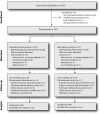Prevention of recurrent foot ulcers with plantar pressure-based in-shoe orthoses: the CareFUL prevention multicenter randomized controlled trial
- PMID: 24760263
- PMCID: PMC4067390
- DOI: 10.2337/dc13-2956
Prevention of recurrent foot ulcers with plantar pressure-based in-shoe orthoses: the CareFUL prevention multicenter randomized controlled trial
Abstract
Objective: To assess the efficacy of in-shoe orthoses that were designed based on shape and barefoot plantar pressure in reducing the incidence of submetatarsal head plantar ulcers in people with diabetes, peripheral neuropathy, and a history of similar prior ulceration.
Research design and methods: Single-blinded multicenter randomized controlled trial with subjects randomized to wear shape- and pressure-based orthoses (experimental, n = 66) or standard-of-care A5513 orthoses (control, n = 64). Patients were followed for 15 months, until a study end point (forefoot plantar ulcer or nonulcerative plantar forefoot lesion) or to study termination. Proportional hazards regression was used for analysis.
Results: There was a trend in the composite primary end point (both ulcers and nonulcerative lesions) across the full follow-up period (P = 0.13) in favor of the experimental orthoses. This trend was due to a marked difference in ulcer occurrence (P = 0.007) but no difference in the rate of nonulcerative lesions (P = 0.76). At 180 days, the ulcer prevention effect of the experimental orthoses was already significant (P = 0.003) when compared with control, and the benefit of the experimental orthoses with respect to the composite end point was also significant (P = 0.042). The hazard ratio was 3.4 (95% CI 1.3-8.7) for the occurrence of a submetatarsal head plantar ulcer in the control compared with experimental arm over the duration of the study.
Conclusions: We conclude that shape- and barefoot plantar pressure-based orthoses were more effective in reducing submetatarsal head plantar ulcer recurrence than current standard-of-care orthoses, but they did not significantly reduce nonulcerative lesions.
Trial registration: ClinicalTrials.gov NCT00803608.
© 2014 by the American Diabetes Association.
Figures
References
-
- Pecoraro RE, Reiber GE, Burgess EM. Pathways to diabetic limb amputation. Basis for prevention. Diabetes Care 1990;13:513–521 - PubMed
-
- Driver VR, Yao M. Discussion. The economics of limb salvage in diabetes. Plast Reconstr Surg 2011;127(Suppl. 1):296S–297S - PubMed
-
- Driver VR, Fabbi M, Lavery LA, Gibbons G. The costs of diabetic foot: the economic case for the limb salvage team. J Vasc Surg 2010;52(Suppl.):17S–22S - PubMed
-
- Gordois A, Scuffham P, Shearer A, Oglesby A, Tobian JA. The health care costs of diabetic peripheral neuropathy in the US. Diabetes Care 2003;26:1790–1795 - PubMed
Publication types
MeSH terms
Associated data
Grants and funding
LinkOut - more resources
Full Text Sources
Other Literature Sources
Medical



